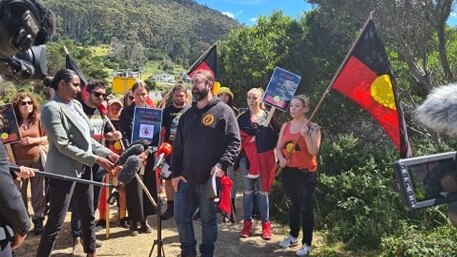U-turn on road project in wake of Aboriginal grave outcry
A controversial road project at a nationally significant Aboriginal grave site in Tasmania will be scrapped in favour of a less intrusive alternative.

A controversial road project at a nationally significant Aboriginal grave site in Tasmania will be scrapped in favour of a less intrusive alternative, in an attempt to head-off global outrage.
The $3.75m road project at Eaglehawk Neck, a known Aboriginal burial site and suspected massacre scene, with up to 80 graves, caused a national outcry late last year.
Historian Lyndall Ryan warned of “international outrage” if the isthmus site, which she believed was likely to be a significant massacre burial site, was damaged by the 600m road widening with new footpath, bus stop and turning lanes.
The state government angered some Aboriginal groups by planning to excavate pits at the site, on the Tasman Peninsula, to look for remains or artefacts.
However, The Australian understands the government has suspended the pit digging and scrapped the road plans in favour of a redesign, with construction likely to be delayed by 12 months.
The new plan, to be unveiled to Aboriginal groups in February, will stick more closely to existing infrastructure footprint and already disturbed areas.
“We have committed to reviewing the design in order to minimise, and if possible to avoid, any impact to Aboriginal heritage values,” a Department of State Growth spokesman said.
“Once the review is complete in early 2021 we will consult further with the Aboriginal community and other key stakeholders.”
Several sources said the redesign was well under way, if not complete, while indigenous leaders had been advised of the change of heart.
Aboriginal Heritage Tasmania chairman Rodney Dillon said the revamp was likely to avoid the need to dig exploration pits. “On both sides of the road it’s already been disturbed and … upheaved,” he said. “It (the new design) is not going to be much different to what it is now.”
He praised State Growth’s willingness to work with Aboriginal Heritage on the issue. “They have been going about it the right way,” he said. “I think there’ll be a good outcome.”
Long term, there would need to be “wide-ranging” investigation of the site to determine the age of the remains and the cause of death. “We’ve got to have the truth of what it is,” he said.
The local Parrdarrama Pungenna Aboriginal Corporation was “looking forward to seeing” the revised plan. Corporation secretary Peter Macdonald said the rethink was likely to delay the project for 12 months but could be done without disturbing remains or artefacts.
Tasmanian Aboriginal Centre campaign manager Nala Mansell said the group was open to a scaled-backed proposal if it avoided middens or graves but wanted to see the detail.
Large numbers of remains were uncovered in the area in 1919 and referenced again in the 1960s, with theories focusing on massacre by Europeans, disease outbreak, ancient graves, or multiple events.




To join the conversation, please log in. Don't have an account? Register
Join the conversation, you are commenting as Logout